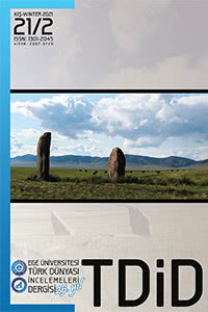19. Yüzyılda Buhara Hanlığı’nda bir seyyah ve Tabip: Johann Martin Honigberger
Dr. Honigberger, tıp adamı ve bir seyyah olarak ilgi çekici bir şahsiyettir. Aldığı tıp eğitiminden sonra Doğu’ya olan merakı sebebiyle Osmanlı Devleti’nin çeşitli coğrafyalarında vazife yapmış, Sih Devleti’nde uzun süre hükümdarın doktoru olarak hizmet etmişti. O bu görevleri sırasında ilginç gelişmeleri gözlemleme fırsatı bulmuştur. Zorluklardan yılmayan ve yaşadıkları ile tecrübelerini yazarak önemli bir seyahatname oluşturan Honigberger, Buhara’ya da gitmiş, burada bir süre kalmış ve Buhara’daki yetkililerle görüşmelerde bulunmuş ve ayrıca bu şe- hirde mesleğini de icra etmiştir. Onun bu izlenimleri 18. yüzyılın ilk yarısında Buhara Emirliği’nin tarihi hakkındaki bilgilerimize katkılarda bulunacak niteliktedir. Özellikle Buhara’nın yöneticisi olan kuşbeyi ile ilgili tespitleri, Buhara’nın sağlık konusundaki yetersizliği ile ilgili görüşleri oldukça önemlidir.
A traveler and a physician in the Khanate of Bukhara in 19th century: Johann Martin Honigberger
Dr. Honigberger is an interesting personality as a traveler and physician. After his medical education he served in various lands of the Ottoman Empire, since he was interested in the East, and served in the Sikh state as doctor of the ruler for a long time. He had the opportunity to observe interesting events during his tasks. Honigberger, who was not intimidated by the difficulties, and who composed an important travel book by writing his experiences, went to Bukhara and stayed there for a while and negotiated with the authorities and practiced his profession in this city, too. His impressions make contribution to our knowledge about the Emirate of Bukhara’s history in the first half of the 18th Century. Especially his views about the koshbegi and opinions about the inadequacy in health issues are very important.
___
- BREGEL Yuri, “The New Uzbek States : Bukhara, Khiva and Khoqand: c. 1750-1886”, The Cambridge History of Inner Asia. The Chinggisid Age , ed. Nicola di Cosmo, Allen J. Frank and Peter Golden, Cambridge 2009.
- DEMEZON P. İ. – VİTKEVİÇ İ. V., Zapiski o Buharskom Hanstve, Moskova 1983.
- HONIGBERGER John Martin, “Thirty-FiveYears in the East Adventures, Discoveries, Experimentes and Historical Scetches Relating to the Puhjab and Cashmere”, Connection with Medicine, Botany, Phamacy, Late Physician to the Court of Lahore, Calcutta 1905.
- von KUGELGEN Anke, “Buchara im Urteil Europäischer Reisender Des 18. und 19. Jahrhunderts”, Muslim Culture in Russia and Central Asia from the 18th to the Early 20th Centuries, ed. Michael Kemper, Anke von Kügelgen, DmitriyYermakov, Berlin 1996.
- MUHTAROV A., “The Mangits”, History of Civilizations of Central Asia, Vol.5, Paris 2003, s.55-63.
- OLUFSEN Ole, The Emir of Bokhara and his Country: Journeys and the Studies in Bokhara , London 1911.
- POUJOL Catherine, Dictionnaire de l’Asie Centrale, Paris 2001.
- POUJOL Catherine, “Desmaisons, Jean Jacques-Pierre”, Iranica, Vol.VII, Fasc.3, 2011, s.331.
- SAINT-MARTIN Louis Vivien de, Histoire des Découvertes Géographiques des Nations Européennes dans les Diverses Parties du Monde, Paris 1846.
- SIGALÉA Robert, Johann-Martin Honigberger: Medecin et Aventurier de l’Asie, Paris, 2003.
- SUHAREVA A. Olga, Buhara XIX-Naçalo XXV veka, Moskova 1966.
- WILDER Alexander, History of Medicine, New Sharon 1901.
- ZARCONE Thierry, Yasak Kent Buhara 1830-1888. Bir Efsanenin Fethinde Modern Batı, çev. Ali Berktay, İstanbul 2001.
- ISSN: 1301-2045
- Başlangıç: 1996
- Yayıncı: Ege Üniversitesi Türk Dünyası Araştırmaları Enstitüsü
Sayıdaki Diğer Makaleler
19. Yüzyılda Buhara Hanlığı’nda bir seyyah ve Tabip: Johann Martin Honigberger
Sungur Türkçesi Atasözü Örnekleri
Arap Baharı ve Orta Doğu: Çok Eksenli Güç Mücadelesinde Denge Arayışları
Tebrizli Âşık Ali'nin Kanatlı Ses Şiiri ve Bahtiyar Vahapzâde'nin Bu Âşığa Cevabı
Namık Kemal ve Ziya Paşa'nın "Rüya"ları
Resul Rıza'nın Şiirlerinde "Ezop Dili"
Tebrizli Âşık Ali’nin Kanatlı ses Şiiri ve Bahtiyar Vahapzâde’nin bu Âşığa cevabı
